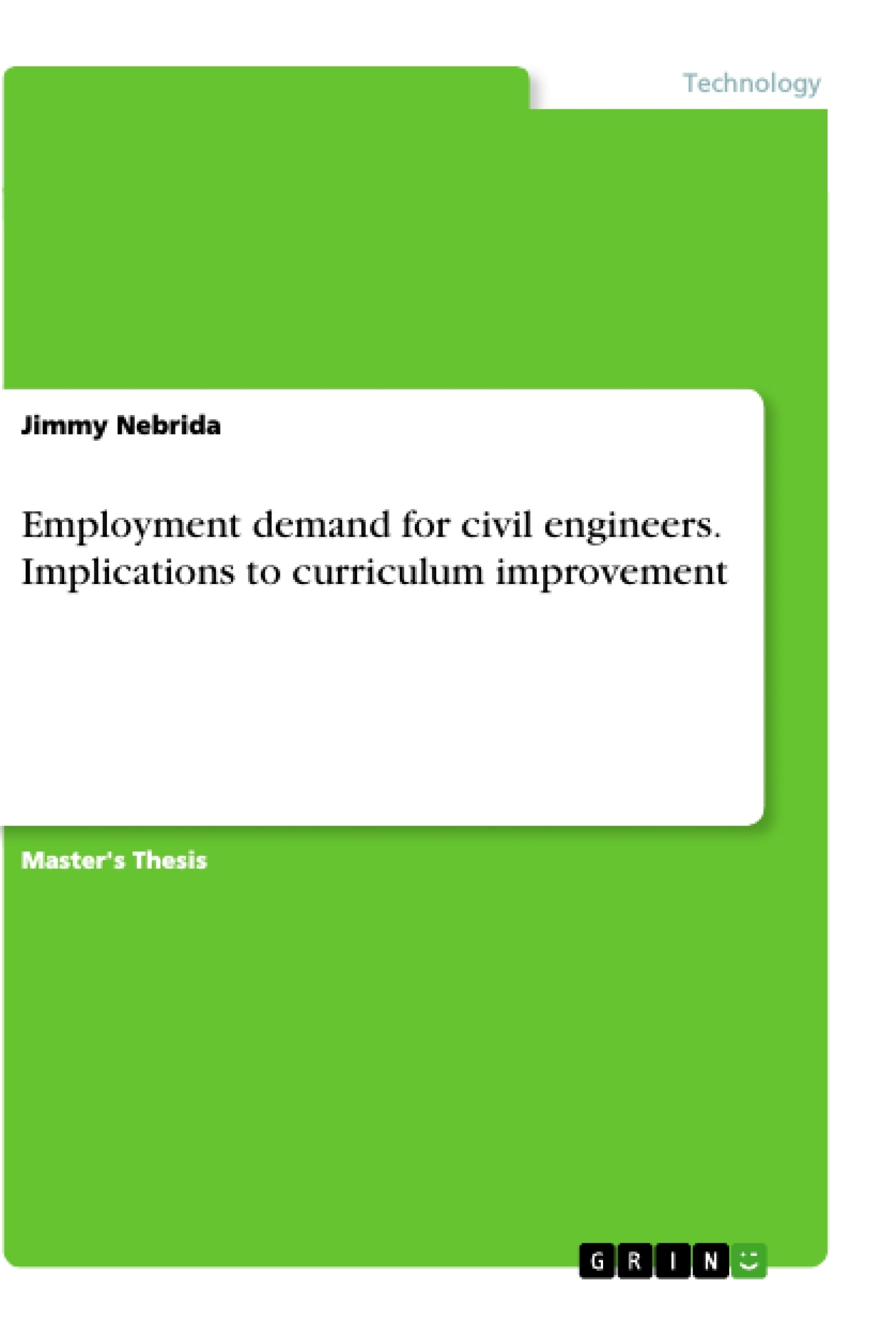This study was conducted to determine the employment demand for civil engineers and its implications to curriculum improvement. Specifically, this study aimed to know the profile of the civil engineer-respondents in terms of age, sex, eligibility, status of employment, number of trainings/seminars attended, number of years of experience, and highest educational attainment; to know the employment demand for civil engineers, who are UEP graduates, in terms of communication skills, computer skills, managerial skills, technical expertise, environmental awareness, linkages with other agencies and keeping abreast with new technologies as perceived by themselves and by their immediate supervisors.
The study also assessed the relationship between the profile of the civil engineer-respondents and their employment demand. The difference of the perceptions of the civil engineer-respondents and their immediate supervisors on employment demands were also looked into. This study employed descriptive-correlational method of research involving two groups of respondents, the 55 civil engineer-respondents and the 15 immediate supervisors. Three sets of questionnaire were utilized to gather information needed.
Table of Contents
- Chapter 1: Introduction
- Chapter 2: Review of Related Literature
- Chapter 3: Methodology
- Chapter 4: Presentation, Analysis and Interpretation of Data
- Chapter 5: Summary, Conclusions, and Recommendations
Objectives and Key Themes
This study aimed to determine the employment demand for civil engineers and its implications for curriculum improvement. It investigated the profile of civil engineer respondents and assessed the employment demand for University of Eastern Philippines (UEP) graduates, considering various skills and attributes. The study also analyzed the relationship between respondent profiles and employment demand, as well as the differences in perception between engineers and their supervisors.
- Employment demand for civil engineers
- Skills and competencies required in the profession
- Curriculum improvement based on employment needs
- Perceptions of employers and employees regarding skills gaps
- Relationship between engineer profile and employment success
Chapter Summaries
Chapter 1: Introduction: This chapter introduces the study, highlighting the importance of understanding the employment demand for civil engineers to improve relevant curricula. It establishes the research problem, stating the need to align educational programs with industry requirements. The chapter likely lays out the study's objectives, research questions, and the significance of the findings for both educational institutions and the engineering profession.
Chapter 2: Review of Related Literature: This chapter provides a comprehensive review of existing literature on employment trends in civil engineering, focusing on skills gaps, curriculum development, and the importance of aligning education with industry needs. It likely synthesizes findings from previous research on similar topics, providing a theoretical foundation for the current study and highlighting relevant theories or models that inform the research design. The chapter will likely discuss the challenges and opportunities in the civil engineering field and connect them to the importance of effective curriculum design.
Chapter 3: Methodology: This chapter details the research design, data collection methods, and the statistical techniques employed in the study. It describes the population and sample, the instruments used to gather data (e.g., surveys, interviews), and the procedures followed to ensure data validity and reliability. The chapter also outlines the specific statistical analyses performed to answer the research questions, including how the data will be presented and interpreted.
Chapter 4: Presentation, Analysis and Interpretation of Data: This chapter presents the findings of the study, analyzing the data collected through the chosen methodology. It organizes the results systematically, perhaps using tables and graphs, to illustrate the key findings related to the employment demand for civil engineers and their perceived skills. The chapter likely compares and contrasts the perceptions of the civil engineers and their supervisors, examining any significant differences or agreements. This section forms the core of the research, providing evidence to support or refute the hypotheses or research questions.
Keywords
Civil engineering, employment demand, curriculum improvement, skills gap, competency, professional development, higher education, workforce needs, industry requirements, survey research.
Frequently Asked Questions: Comprehensive Language Preview of Civil Engineering Employment Demand
What is the purpose of this study?
This study aims to determine the employment demand for civil engineers and its implications for curriculum improvement at the University of Eastern Philippines (UEP). It investigates the profile of civil engineer respondents, assesses employment demand, analyzes the relationship between respondent profiles and employment demand, and compares the perceptions of engineers and their supervisors regarding skills and attributes.
What are the key themes explored in this study?
The key themes include the employment demand for civil engineers, the skills and competencies required in the profession, curriculum improvement based on employment needs, perceptions of employers and employees regarding skills gaps, and the relationship between engineer profile and employment success.
What chapters are included in this study?
The study comprises five chapters: an introduction, a review of related literature, a methodology chapter, a chapter presenting, analyzing, and interpreting the data, and a concluding chapter summarizing the findings, conclusions, and recommendations.
What does Chapter 1 (Introduction) cover?
Chapter 1 introduces the study, highlighting the importance of understanding employment demand for civil engineers to improve curricula. It establishes the research problem, objectives, research questions, and the significance of the findings.
What does Chapter 2 (Review of Related Literature) cover?
Chapter 2 provides a comprehensive review of existing literature on employment trends in civil engineering, focusing on skills gaps, curriculum development, and aligning education with industry needs. It synthesizes findings from previous research and provides a theoretical foundation for the study.
What does Chapter 3 (Methodology) cover?
Chapter 3 details the research design, data collection methods (e.g., surveys, interviews), and statistical techniques used. It describes the population and sample, instruments used, and procedures for ensuring data validity and reliability.
What does Chapter 4 (Presentation, Analysis and Interpretation of Data) cover?
Chapter 4 presents the study's findings, analyzing the collected data using tables and graphs. It illustrates key findings related to employment demand and perceived skills, comparing and contrasting the perceptions of engineers and their supervisors.
What does Chapter 5 (Summary, Conclusions, and Recommendations) cover?
Chapter 5 summarizes the study's findings, presents conclusions based on the data analysis, and offers recommendations for curriculum improvement and addressing skills gaps in civil engineering education.
What are the keywords associated with this study?
The keywords include: Civil engineering, employment demand, curriculum improvement, skills gap, competency, professional development, higher education, workforce needs, industry requirements, and survey research.
- Citar trabajo
- Professor Jimmy Nebrida (Autor), 2022, Employment demand for civil engineers. Implications to curriculum improvement, Múnich, GRIN Verlag, https://www.grin.com/document/1168746




